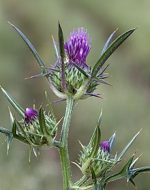 Also known as horse thistle, this annual plant is native to the semi-desert areas of the Mediterranean region and the Middle East. It is a member of the aster family, Asteraceae, that also includes daisy, yarrow, and lettuce. Plants grow up to 3′ tall from a rosette of leaves and have erect stems that are bluish and branched above. The gray-green leaves have white veins, sharp spines on the margins and apex, and are smooth above, softly hairy below. Basal leaves are elliptical while stem leaves are more lanceolate with the uppermost ones almost reduced to spines. Purple flowerheads are .8″ across and appear singly or in terminal clusters from winter to spring. Each flowerhead is subtended by leaves modified into sharp spines. The fruit is an achene with plumose pappas hairs. Syrian thistle is often found growing along roadsides and fields, and can invade pasture land, reducing the available forage. The genus name, Notobasis, is from the Greek words notis meaning moisture and basis meaning base or pedestal, and refers to the habitat. The specific epithet, syriaca, is the Latinized word for Syria, and refers to an area where the plant is found.
Also known as horse thistle, this annual plant is native to the semi-desert areas of the Mediterranean region and the Middle East. It is a member of the aster family, Asteraceae, that also includes daisy, yarrow, and lettuce. Plants grow up to 3′ tall from a rosette of leaves and have erect stems that are bluish and branched above. The gray-green leaves have white veins, sharp spines on the margins and apex, and are smooth above, softly hairy below. Basal leaves are elliptical while stem leaves are more lanceolate with the uppermost ones almost reduced to spines. Purple flowerheads are .8″ across and appear singly or in terminal clusters from winter to spring. Each flowerhead is subtended by leaves modified into sharp spines. The fruit is an achene with plumose pappas hairs. Syrian thistle is often found growing along roadsides and fields, and can invade pasture land, reducing the available forage. The genus name, Notobasis, is from the Greek words notis meaning moisture and basis meaning base or pedestal, and refers to the habitat. The specific epithet, syriaca, is the Latinized word for Syria, and refers to an area where the plant is found.
Type: Annual
Bloom: Solitary or clusters of purple flowerheads surrounded by leaves modified into sharp spines in winter to spring
Size: 3′
Light: Full sun
Soil: Average, dry to medium moist, well-drained
Hardiness: Not relevant
Care: Not relevant
Pests and Diseases: Unavailable
Propagation: Seed
Companion Plants: Not relevant
Outstanding Selections: Not relevant
Photo Credit: Wikidata